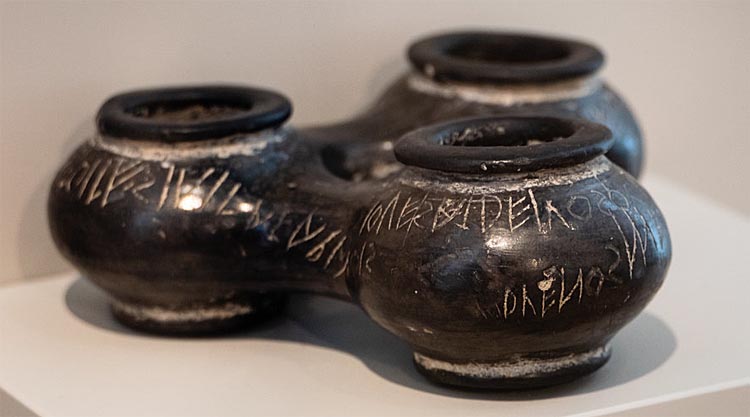The Dueno’s Vase 0 Commentaires

The oldest document is written in Sardinian
The Etruscan tradition used the so-called "talking objects". It concerned the handmade product where an engraved message was speaking firsthand to whom the object was given.
Dueno's vase, a kernos (container made up of several identical bowls joined together, in this case, a vase made up of three matching containers) was found in Rome, in 1880, at the Quirinale, and was deciphered and dated in the second half of the 6th century BC by Heinrich Dressel, a German archaeologist. Today the vase sits in the Berlin's State Museums.
Dueno's vase has so far been reputed to be one of the oldest documents written in Latin:
IOVE | SATDEIVOSQOIMEDMITATNEITEDENDOCOSMISVIRCOSIED / ASTEDNOISIOPETOITESIAIPACARIVOIS / DVENOSMEDFECEDENMANOMEINOMDVENOINEMEDMALOSTATOD,
and most likely was named after the craftsman of the vase, Duenos. The vase had been commissioned to him probably by a woman named Toteria, with a threatening message for the lover who had rejected her: "She who sends me prays the gods that no virgin is to be your companion if you do not want to be satisfied by Toteria." To which the potter, who wanted to remain out of the diatribe and to keep his distances from the curse, added:" A good man made me, and because of me in the hands of that good man do not return evil. " In other words, he said: "don’t shoot the messenger!"
Actually, the story is intriguing and pleasant, but today we would not be writing on this blog about the vase if a piece of very interesting news had not occurred! The Dueno’s Vase, the most ancient "Latin document", is in reality written in Sardinian'' says the linguist Bartolomeo Porcheddu, professor of the Sardinian language laboratory at the Cagliari University, who declares: “The oldest Latin document is written in Sardinian. Dueno's Vase is a talking object. In the first place, because it reproduces a "Trine", that is the conjunction between Jupiter and Saturn with respect to the sun and the earth that manifests itself in the night sky. When these two planets are at a 120 ° distance on the celestial sphere, they draw an equilateral triangle just like the Dueno Vase. In ancient times, this conjunction was considered a gift from heaven. Secondly, the artefact also tells us who the Trine is intended for. The Vase is a donation to Jupiter and Saturn, a request to vote so that a wish expressed by the person who commissioned the work is fulfilled.”
But how can it be that a Roman vase from the second half of the 6th century BC. was written in Sardinian? Bartolomeo Porcheddu replies: "Because ancient Sardinian has been the universal language of the Mediterranean for years. In 600 BC we are in a phase of decline of the Nuragic civilization, but the influence of the language is still very strong. The Latin that will then be used will be built on a table based on ancient Sardinian’s basis, the language to which Greek cases will be applied.” “Nobody has noticed it for two thousand years, because nobody has focused on the comparative study between Latin and ancient Sardinian". And again: "The Dueno vase was produced before the Romans transformed their Sardinian-Latin language into the 'common Latin' language by inserting the Greek 'cases' into the nominal morphemes."
Great disagreements are now expected between scholars and, why not, between keyboard lions, with pros and cons on the new theory, but the fact that one of the oldest documents of the Latin language might have been written in ancient Sardinian, well, not only pricked our curiosity, but it also added a cockade of island pride!
“Truth, like water, takes the shape of the vase containing it.” (Ibn Khaldun)
--
Written by Daniela Toti
Photo was taken from the web
Share your opinion with us!